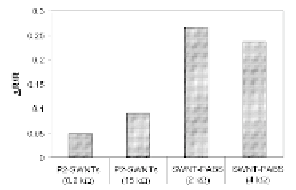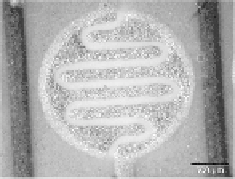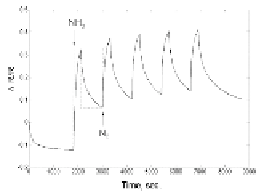Biomedical Engineering Reference
In-Depth Information
between IDE electrodes was explored as a device configuration for
development of advanced gas sensors.
(a)
(c)
(b)
(d)
Figure 9.16
(a) Interaction scheme of the modified SWNT-PABS, having
functional
groups
attached
of
poly
m
-aminobenzene
sulfonic acid (PABS), with NH
gas molecules. (b) Optical
image of the interdigitated electrode used for the CNT-
based sensor. (c) Response of the unmodified (P2-SWNTs)
with different electrical resistance and the PABS-modified
SWCNTs (SWCNT-PABS) with different electrical resistance.
(d) Response curves of the PABS-modified SWCNTs (SWNT-
PABS) toward 100 ppm NH
3
. This figure is reprinted and
adapted with permission from ACS [173].
3
Furthermore, Dai
[175] developed a SWCNT sensor
modified with two distinct polymers of polyethyleneImine (PEI) and
Nafion by imparting high sensitivity and selectivity to NO
et al.
,
respectively. Figure 9.17 shows the optical image of three CNT sensors
with microelectrodes prepared by dropping CNT-polymer solutions.
Arrays of devices comprising multiple SWCNTs bridging metal
electrodes were obtained by CVD nanotubes across prefabricated
electrode arrays. This ensemble of modified nanotubes exhibited
specifically large electrical conductance changes under chemical
and NH
2
3






